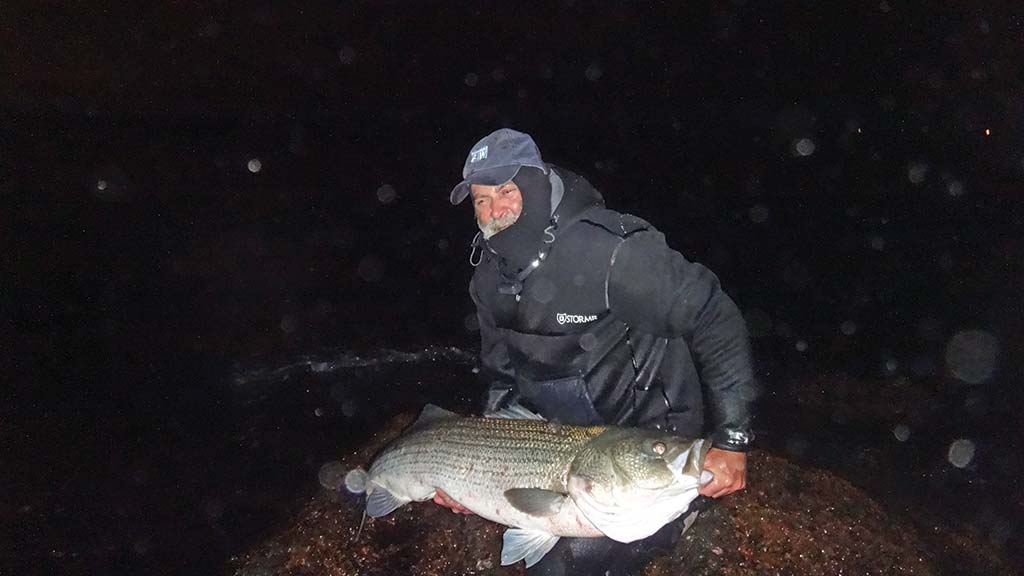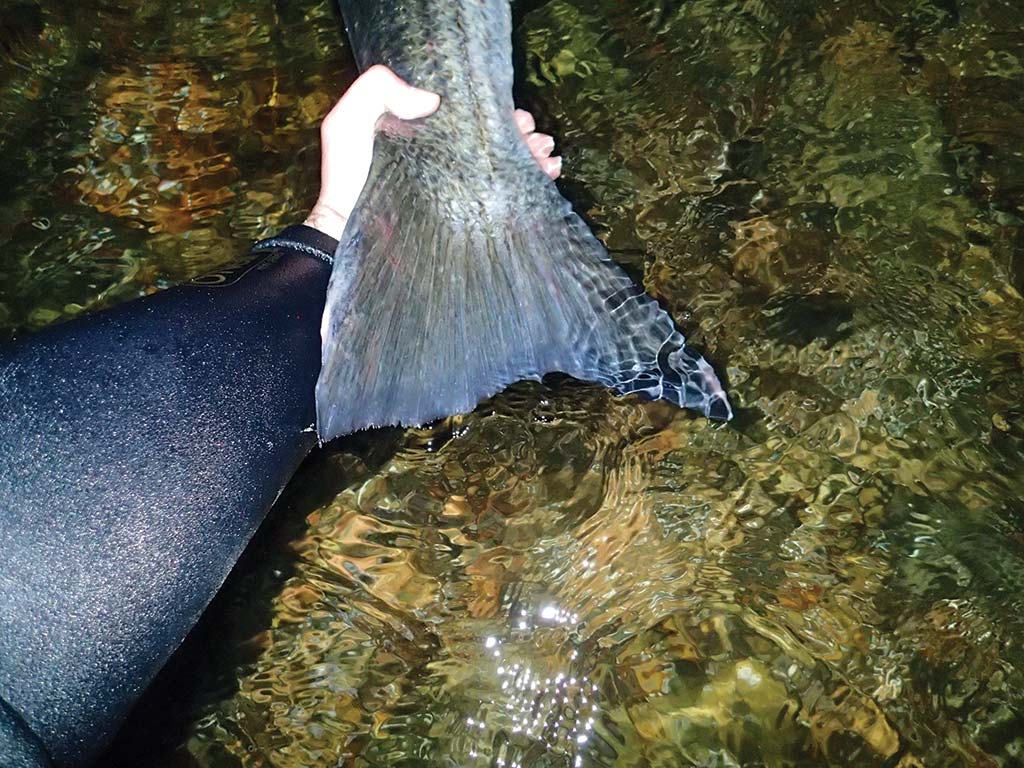
Being able to select the right plug to match the many moods of the surf can be a game changer.
Sometimes you just know that you have to get out there and fish. Sometimes the conditions are just too ‘right’ and you cannot ignore that instinctual pull to drop everything and just go. I feel like September is the fastest month of the year and it’s the one with the most dramatic weather change over its 30 day span, maybe March could rival it, but when September begins you know it’s summer and when it ends, you definitely know that it’s fall.
The ninth month in the Northeast wipes the summer slate clean. Patterns are nowhere near concrete and what worked last year might not work at all this year. Bodies of fish cannot be counted on to show up when you think they should, but you also can’t discount the fact that they might be there again. Patterns are beaten into us as surfcasters, but my experience has been that our tendency to keep trying to make what worked last time work again is a big mistake and waste of time, especially in September. Another thing about September is that the surf cannot really ever be too rough, it can be too dirty or weedy, but big seas in September often mean faster action – and sometimes, bigger fish.
Reading The Surf
As the title alludes, the surf displays many attitudes and its moods are often transposed into the minds of the fish. The game is not so much catching fish as it is throwing something that doesn’t look out of place within the conditions at the time. One night I was certain there would be fish on a shallow point that I often fish. It’s a bear to get into this place but that’s one of the things I love about it – I’m usually the only one there. I walked out onto the point and waded to my waist, then I fell into that reliance on previous experience that we all sometimes suffer from. I snapped on a slow-sink wood needlefish, one that I had caught many fish on in that very spot. Cast after cast, I would get little kisses and bumps from bass in the wash, but they would not commit. For half an hour – maybe – more, I dug in, determined to find the speed or imparted action that would turn the fish on. I was able to connect twice; one was a foul-hooked schoolie and the other a 30-inch fish that hit the plug so gently I was surprised to hook up at all.
Gentle hits tell conflicting stories in my experience. Either the fish are timid and want something smaller or they are getting too good a look at the plug and they are testing it out to see if it’s actually alive. This is when the surfcaster has to read the surf to make the correct determination. When would the fish get the best look at your offering? When the water is calm and clear, of course. So this is when downsizing, slowing down and trying to reduce the sink rate of your plug or lure is likely to draw strikes from fish that are wary of larger offerings.
The night in question wasn’t terribly rough but there was enough surf to keep the whitewater at full froth. It wasn’t easy to keep my feet planted either so you know the fish were constantly being jostled around in water that never stopped moving. If you try to put yourself in that situation, you can picture that you’d have to move with the waves and current. Baitfish would be trying to stay down in the weeds and rocks, getting
flushed out when waves rolled through and broke, the flushed baitfish freaking out and speeding for cover. Now picture my needlefish, slowly sliding through the frenetic scene, staying up in the column, displaying the opposite mood to the rest of the bait in the area. It doesn’t make sense, does it? Everything is moving fast, the surf forcing the fish and baitfish into a chaotic mode of competitive feeding and fleeing. A slowly-moving lure is so out of place in that situation, those gentle pokes could almost be read as sarcastic —like, ‘seriously, you think I believe this is real!?’
I finally came to my senses and switched out for a large soft plastic on a 3/4-ounce head. The weight of the head in water that shallow (5 feet and under) meant that I’d be staying down but also that I would need to keep the lure moving quickly or risk hanging up in the rocks. I threw the 9-inch rubber out there and did nothing more than reel it in quickly. The changeup did everything I hoped it would. I went from two fish in 30 minutes to more than 30 fish in the next 2-1/2 hours. It was not a night of giants, but bass from 10 to 20 pounds, hitting one after another on a competitive feed – I’ll take it!

Rooted In Truth
Clichés are annoying and I definitely ‘get’ the tendency to want to avoid giving in to them, but they are so often rooted in raw truth. Last fall I went out with a friend of mine along a rocky Rhode Island beach that shall remain nameless. He had been into fish for a few days and invited me to join him. He was getting the fish on needles in heavy surf, in fact the surf was so heavy that he had been knocked down and broke his rod. He was hooking a wide range of sizes on the ‘red eye’ needles from Super Strike in that slop. The water had calmed down considerably on the night that I joined him and the needles were still catching, but the fish were much smaller—averaging around 24 inches.
When things change, I try to step back and make sense of what is in front of me. At first I was fixated on the reef that was about 60 yards out from where we stood. The waves were spilling over it and the water was pushing along the shore away from me. I tried to use needles and darters to swing out of the whitewater into that slow current, hoping to find an edge where the larger fish might be setting up. This method produced plenty of fish, but nothing of size. I moved down the shore to where the swing would carry my plug in tight to the next section of reef, still no change in size or action.
This time it was the relative lack of chaos that made me think about going deeper. The mullet were around in force and, because we were fishing on stepped ledge, there was no shallow break for the baitfish to hold in. I figured that the mullet would be down deep trying to stay hidden from the very abundant stripers waiting in front of us. Jigs and soft plastics on leadheads were again my first choice, this time to get down and stay down, hoping to punch through the aggressive schoolies at the surface. After I landed five fish in a row over 20 pounds, I made the strong suggestion to my counterpart to make the same switch. The bite went red hot and we upped the average size by 10 inches, all with a simple change in approach. It’s an accepted cliché that the larger fish will hang deep under the smaller ones, but it’s also very often the truth.
Hiding In Plain Sight
ROUGH:
When the surf is angry, I try to make my presentation appear to be scared and running for its life. The plug I usually each for first is a Bottle Plug because of its ability to hold in heavy surf and because it’s vibrations are already frantic. Hard sweeps of the rod in heavy waves will often draw vicious strikes.
WHITEWATER:
When the surf line is blanketed in white, I like to fish fast but I experiment with staying deep or staying high in the column. When swimming with a mask in whitewater, I have seen baitfish being flushed out of the rocks and weeds, only to dive back into cover in the next blink. So basically, I’m trying to replicate different modes of nervousness.
MODERATE:
In moderate surf, anything goes. This is when experience will help you make the right choice based on the wave intervals or how the bottom topography is affecting the intensity of the waves. Because moderate surf is a pretty common condition, I reason that the bait must be used to it and I try to fish with the image of a mostly relaxed baitfish my head.
GENTLE/FLAT:
Believe it or not, calm water is my preferred condition for hunting big fish. I don’t want to stand out too much when it’s flat. So I typically throw buoyant plugs that I can fish painfully slow. My mindset is that I’m trying to draw a fish to investigate with not much more than the water displacement of the plug.
About 10 years ago, I went out scouting for fish under a bright September sun. My hopes were not high as an offshore hurricane was battering the shore with mountainous waves, the water was filth, and, again, that bright sun. But I found fish crushing bait right in the teeth of the groundswell, I couldn’t get my wetsuit on fast enough! These fish loved any fast-moving topwater I threw, the faster the better. I had fish up to the high 20-pound class. The fish stayed a few days and continued to show a deep love for plugs streaked at crazy speeds—day and night. Then the offshore storm moved far enough away to kick the winds around to the north, that clearing wind laid the surf flat in a matter of hours.
That night, it seemed silly to be skipping needlefish like epoxy jigs, but we tried anyway. It didn’t work. It almost seemed like the fish had moved on, but when we switched to darters and fished them just fast enough to feel the resistance of the plug, the bite fired right back up. You might have a different theory than I do for why this happened, but I’ll give you mine. When the water goes placid like that, baitfish have only two options, hide in the shallows or move as little as possible. It’s no secret that predator fish have a sixth sense, their ability to sense and locate vibration in the water through their lateral line. A baitfish swimming over deep water is going to be detected quickly through this sense and evolution has taught them to stay still and drift with the current until they can make a run for safety. It’s almost as if, in the dark, they can hide in plain sight if they limit the vibrations they put off. The slow-moving darter seemed to give off the perfect mix of slow-movement and relative stillness to replicate a mullet that was doing a terrible job of this ‘hiding in plain sight’ routine. We had fish well into the upper 30-pound range that night, but when that tide changed, the fish left and never came back.
Attitude Adjustments
September is here and it will be gone before you know it. Consider the fact that most people cannot fish more than three nights per week, and that is a generous estimate for most. That translates to 12 trips in September. If you waste 30 minutes every trip trying to make the fish eat what worked last year. That is six hours of wasted fishing time. I would wager that for the average surfcaster that equals about two trips worth of wasted time. However, if you go into the trip with the assumption that you will take some time to assess the attitude of the surf, I’m certain that you’re going to waste a lot less time, learn something new about the surf and catch a few more fish too.




